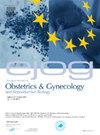阴道铒激光与盆底肌锻炼治疗盆腔器官脱垂:随机对照试验。
IF 2.1
4区 医学
Q2 OBSTETRICS & GYNECOLOGY
European journal of obstetrics, gynecology, and reproductive biology
Pub Date : 2024-10-26
DOI:10.1016/j.ejogrb.2024.10.042
引用次数: 0
摘要
目的:比较 Er:YAG 激光治疗轻度和中度盆腔器官脱垂的疗效:比较Er:YAG激光治疗轻中度盆腔器官脱垂(POP)与盆底肌锻炼(PFE)的疗效:设计:单中心随机对照试验:设计:单中心随机对照试验:46名患有轻度至中度脱垂的妇女参加了试验(每组23人)。主要结果无数据缺失;3名患者在24个月后失去随访机会:主要结果测量指标:通过盆腔脏器脱垂压力量表-6(POPDI-6)测量四个月后脱垂症状与基线相比的主观变化(主要)、不良事件、其他主观结果以及24个月的独立解剖学评估:4个月时,POPDI-6评分的平均差异为1.09(95 %CI = -6.02;8.12),显示激光疗法与PFE疗法相比无劣效(p = 0.004)。在组内,治疗开始四个月后的平均 POPDI-6 差异,激光治疗组(65.2%(15/23)的激光治疗参与者 "更好 "或 "好得多")往往低于 PFE 治疗组(PFE 组为 60.9%(14/23)),但组间无差异(OR = 1.21;95 %CI = 0.39-3.23)。在其他主观或客观结果方面,组间无明显差异。24 个月时,50% 的激光治疗患者(11/22)和 43% 的 PFE 治疗患者(9/21)要求进行其他治疗。在任何时间点均未发生严重不良事件:结论:阴道激光疗法和PFE疗法对轻度和中度脱垂症状的改善程度相似。结论:阴道激光疗法和PFE疗法对轻度和中度脱垂症状的改善程度相似,两种疗法都有可测量但不持久的效果。两组治疗均未出现不良反应:试验注册:ClinicalTrials.gov(NCT04523298):激光设备由斯洛文尼亚 Fotona 公司在试验期间提供。本文章由计算机程序翻译,如有差异,请以英文原文为准。
Vaginal erbium laser versus pelvic floor exercises for the treatment of pelvic organ prolapse: A randomised controlled trial
Objectives
To compare the efficacy of Er:YAG laser for mild to moderate pelvic organ prolapse (POP) to that of pelvic floor exercises (PFE).
Design
Single center randomised controlled trial.
Setting
Tertiary center, Belgium.
Participants
Forty-six women with mild to moderate prolapse were enrolled (23 in each group). There were no missing data for the primary outcome; three patients were lost to follow-up at 24-months.
Interventions
Comparison of vaginal laser treatment (3–6 applications) to PFE (9–18 sessions).
Main outcome measures
Subjective change in prolapse symptoms at four months from baseline measured by the Pelvic Organ Prolapse Distress Inventory-6 (POPDI-6) (primary), adverse events, other subjective outcomes and independent anatomical assessment up to 24 months.
Results
The mean difference in POPDI-6 scores at 4 months was 1.09 (95 %CI = −6.02;8.12), showing non-inferiority of laser to PFE (p = 0.004). Within groups, the difference in mean POPDI-6 four months following the start of therapy tended to be lower for laser-treatment (65.2 % (15/23) of laser-participants were ‘better’ or ‘much better’) than for PFE (60.9 % (14/23) in the PFE group), yet without difference between groups (OR = 1.21; 95 %CI = 0.39–3.23). There were no obvious between group differences in any other subjective nor objective outcomes. At 24 months, 50 % (11/22) of laser-patients and 43 % (9/21) of PFE-patients requested additional, yet alternative treatment. There were no serious adverse events at any time-point.
Conclusions
Vaginal laser application and PFE improve symptoms of mild and moderate prolapse to a similar extent. Both treatments had a measurable yet not durable effect. There were no adverse events in either arm.
Trial registration
ClinicalTrials.gov(NCT04523298).
Funding
The laser device was provided by Fotona, Slovenia for the duration of this trial.
求助全文
通过发布文献求助,成功后即可免费获取论文全文。
去求助
来源期刊
CiteScore
4.60
自引率
3.80%
发文量
898
审稿时长
8.3 weeks
期刊介绍:
The European Journal of Obstetrics & Gynecology and Reproductive Biology is the leading general clinical journal covering the continent. It publishes peer reviewed original research articles, as well as a wide range of news, book reviews, biographical, historical and educational articles and a lively correspondence section. Fields covered include obstetrics, prenatal diagnosis, maternal-fetal medicine, perinatology, general gynecology, gynecologic oncology, uro-gynecology, reproductive medicine, infertility, reproductive endocrinology, sexual medicine and reproductive ethics. The European Journal of Obstetrics & Gynecology and Reproductive Biology provides a forum for scientific and clinical professional communication in obstetrics and gynecology throughout Europe and the world.

 求助内容:
求助内容: 应助结果提醒方式:
应助结果提醒方式:


